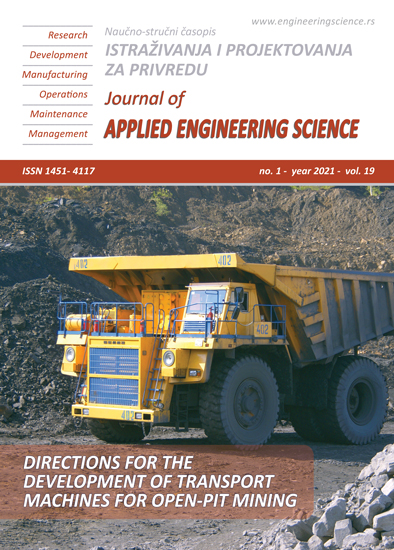DEVELOPMENT OF EQUIPMENT MANAGEMENT SYSTEM WITH MONITORING OF WORKING CHARACTERISTICS OF TECHNOLOGICAL PROCESSES
Abstract
The work provides multi-purpose optimization of the baklava production process based on technology of agent systems, the intelligent environment of process control systems. The general architecture of the control system intelligent environment with agent technologies for recognizing abnormal situations was developed and adaptive baklava production regulators were synthesized. It allows you to get the specified dynamic characteristics of the control object based on the developed adaptive systems for adjusting the PID controllers, controlling the parameters of the dough, kneading, separation and baking of baklava. The proposed approach to the construction of an automated process control system with an intelligent environment will reduce the variance of fluctuations in energy consumption, increase the production rate of high-quality baklava and reduce the time for re-equipment and technological modes of operation of baklava production lines.
References
Almeida, M. V. D. A., Silva, E. M. D., Gomes, N. ., Nunes, L. A. O., & Curi, W. F. (2019). Environmental quality of campina grande landfill based on technical and operational aspects. [Qualidade ambiental do aterro sanitário de campina grande com base em aspectos técnicos e operacionais] Periodico Tche Quimica, 16(32), 77-86.
Blagoveshchenskaya, M.M., & Zlobin L. A. (2005). Information technology of process control systems. M.: Higher School, 2005 .-- 768 p.
Blagoveshchensky I.G., Nazoykin E.A., Tatarinov A.V. (2017). Fundamentals of creating expert food quality control systems using intelligent technologies. Food Industry. No 4. [Electronic resource]. - Access mode: https://cyberleninka.ru/article/n/osnovy-sozdaniya-ekspertnyh-sistem-kontrolya-kachestva-pischevyh-produktov-s-ispolzovaniem-intellektualnyh-tehnologiy (accessed: 01/18/2020).
Cheremisina, O. V., Sergeev, V. V., Chirkst, D. E., & Litvinova, T. E. (2015). Thermodynamic investigation into extraction of cerium(III) by tributyl phosphate from phosphoric acid solutions. Russian Journal of Non-Ferrous Metals, 56(6), 615-621. http:// doi:10.3103/S1067821215060036
Cheremisina, O. V., Sergeev, V. V., Alferova, D. A., & Ilyna, A. P. (2018). Quantitative x-ray spectral determination of rare-earth metals in products of metallurgy. Paper presented at the Journal of Physics: Conference Series, 1118(1) http://doi:10.1088/1742- 6596/1118/1/012012
Chupin, S. A., & Bolobov, V. I. (2017). The investigation of the influence of thermomechanical treatment of the material of rotary cutter bit toolholders on its hardness. Paper presented at the IOP Conference Series: Materials Science and Engineering, 77(1) doi:10.1088/1757-899X/177/1/012062
Gdanskii N.I., Popovich A.I., Goncharov A.V., & Karpov A.V. (2018). Control systems for dynamic processes with single degree of freedom with automatic adaption of the structure and parameters of the system to an external load. Chemical and petroleum engineering. No. 7-8, Vol. 55, pp. 578-589.
Gladilina, I. P., Kurbanov, S. A., Maximov, D. A., Dobrova, E. D., & Dobrova, K. B. (2019). Digital franchising and entrepreneurship: Effects of digital technology on the relations of business process participants. International Journal of Innovative Technology and Exploring Engineering, 9(1), 3892-3896. doi:10.35940/ijitee.A4985.119119
Grigorev, M. B., Tananykhin, D. S., & Poroshin, M. A. (2020). Sand management approach for a field with high viscosity oil. Journal of Applied Engineering Science, 18(1), 64-69. doi:10.5937/jaes18-24541
Goncharov A.V., Popovich A.E., & Budnik A.A. (2019). Methods of adaptive and robust control of technological processes: a training manual. 257 p.
Ivanova, V., Poltarykhin, A., & Szromnik, A. (2020) State regulation of tariffs in the gas sector. Journal of Security and Sustainability Issues, 9 (3), p. 909-917
Kharisova, A. R., & Puryaev, A. S. (2014). Competitiveness assessment of engineering products. IOP Conference Series: Materials Science and Engineering, 69(1), Article number 012020. http://doi.org/10.1088/1757-899X/69/1/012020
Kopteva, A., & Starshaya, V. (2016). Radioisotope measuring system for oil stream asphaltene-resin-paraffin deposits ARPD parameters. Paper presented at the Society of Petroleum Engineers - SPE Russian Petroleum Technology Conference and Exhibition 2016, 2263-2269.
Kozlov, V., Poltarykhin, A., Vasyutkina, L., Ponomarev. V., Filippova, O. & Popkov, S. (2019). Economic and environmental concept of food development in Russia. Journal of Environmental Management and Tourism, Volume X, Issue 7 (39). Page 1509-1517.
Luck, M., McBurney, P., & Preist, C. (2003). Agent technology: Enabling next generation computing. N. Y., Agent Link, 94 p.
Polyakova, A. G., Loginov, M. P., Serebrennikova, A. I., & Thalassinos, E. I. (2019). Design of a socio-economic processes monitoring system based on network analysis and big data. International Journal of Economics and Business Administration, 7(1), 130-139.
Rosa, A. T. R., Pustokhina, I. V., Lydia, E. L., Shankar, K., & Huda, M. (2019). Concept of electronic document management system (EDMS) as an efficient tool for storing document. Journal of Critical Reviews, 6(5), 85-90. doi:10.22159/jcr.06.05.14
Rovnik, N. A., Lushpeev, V. A., Tananykhin, D. S., & Shpurov, I. V. (2020). Rational gas inflow restriction technologies during the development of oil rims. Paper presented at the Topical Issues of Rational use of Natural Resources 2019, 2 888-900. doi:10.1201/9781003014638-54
Skakun, S.V., Kussul N.N., Lobunets A.G. (2005). Implementation of a neural network model of computer system users based on agent technology. Problems of control and computer science. №2. - pp. 3–102.
Tolfo, F. (1989). An introduction to modular batch automation. Control Engineering. no. 9, vol. 36, p. 216–218.
Yumashev, A. V., Koneva, E. S., Borodina, M. A., Lipson, D. U., & Nedosugova, A. B. (2019). Electronic apps in assessing risk and monitoring of patients with arterial hypertension. Prensa Medica Argentina, 105(4), 235-245.
Wooldridge, M. (2002). An introduction to multiagent systems. Chichester, England, John Widey Sons, 366 p.
Zhukovskyy, V., Zhukovska, N., Vlasyuk, A., & Safonyk, A. (2019). Method of forensic analysis for compromising carrier-lock algorithm on 3G modem firmware. Paper presented at the 2019 IEEE 2nd Ukraine Conference on Electrical and Computer Engineering, UKRCON 2019 - Proceedings, 1179- 1182. http://doi:10.1109/UKRCON.2019.8879941

